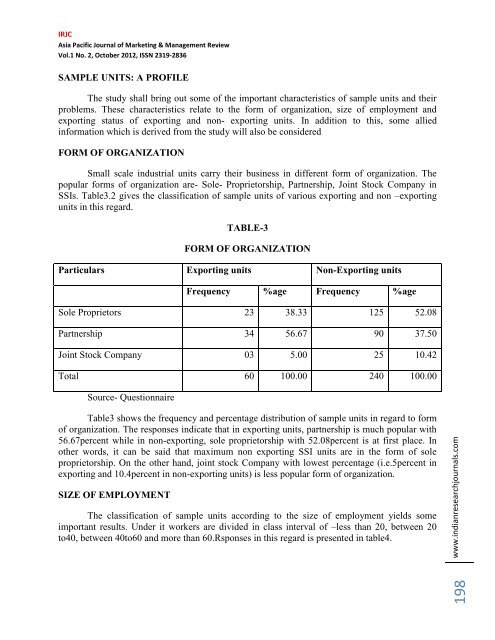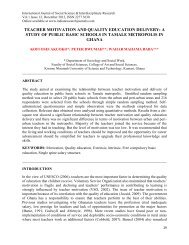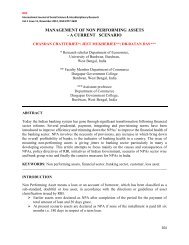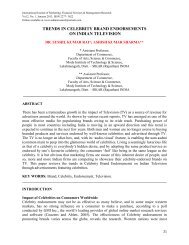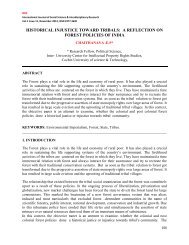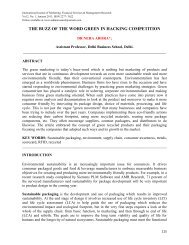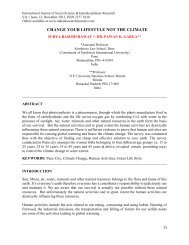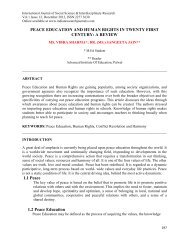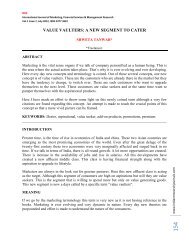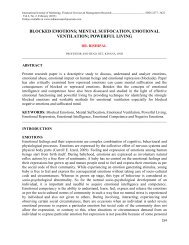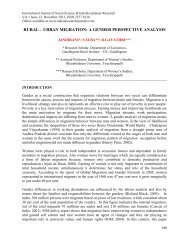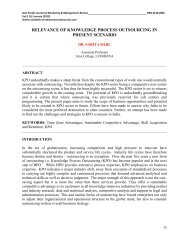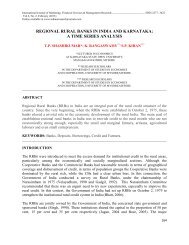problems and prospects of small scale industrial units
problems and prospects of small scale industrial units
problems and prospects of small scale industrial units
You also want an ePaper? Increase the reach of your titles
YUMPU automatically turns print PDFs into web optimized ePapers that Google loves.
IRJC<br />
Asia Pacific Journal <strong>of</strong> Marketing & Management Review<br />
Vol.1 No. 2, October 2012, ISSN 2319-2836<br />
SAMPLE UNITS: A PROFILE<br />
The study shall bring out some <strong>of</strong> the important characteristics <strong>of</strong> sample <strong>units</strong> <strong>and</strong> their<br />
<strong>problems</strong>. These characteristics relate to the form <strong>of</strong> organization, size <strong>of</strong> employment <strong>and</strong><br />
exporting status <strong>of</strong> exporting <strong>and</strong> non- exporting <strong>units</strong>. In addition to this, some allied<br />
information which is derived from the study will also be considered<br />
FORM OF ORGANIZATION<br />
Small <strong>scale</strong> <strong>industrial</strong> <strong>units</strong> carry their business in different form <strong>of</strong> organization. The<br />
popular forms <strong>of</strong> organization are- Sole- Proprietorship, Partnership, Joint Stock Company in<br />
SSIs. Table3.2 gives the classification <strong>of</strong> sample <strong>units</strong> <strong>of</strong> various exporting <strong>and</strong> non –exporting<br />
<strong>units</strong> in this regard.<br />
TABLE-3<br />
FORM OF ORGANIZATION<br />
Particulars Exporting <strong>units</strong> Non-Exporting <strong>units</strong><br />
Frequency %age Frequency %age<br />
Sole Proprietors 23 38.33 125 52.08<br />
Partnership 34 56.67 90 37.50<br />
Joint Stock Company 03 5.00 25 10.42<br />
Total 60 100.00 240 100.00<br />
Source- Questionnaire<br />
Table3 shows the frequency <strong>and</strong> percentage distribution <strong>of</strong> sample <strong>units</strong> in regard to form<br />
<strong>of</strong> organization. The responses indicate that in exporting <strong>units</strong>, partnership is much popular with<br />
56.67percent while in non-exporting, sole proprietorship with 52.08percent is at first place. In<br />
other words, it can be said that maximum non exporting SSI <strong>units</strong> are in the form <strong>of</strong> sole<br />
proprietorship. On the other h<strong>and</strong>, joint stock Company with lowest percentage (i.e.5percent in<br />
exporting <strong>and</strong> 10.4percent in non-exporting <strong>units</strong>) is less popular form <strong>of</strong> organization.<br />
SIZE OF EMPLOYMENT<br />
The classification <strong>of</strong> sample <strong>units</strong> according to the size <strong>of</strong> employment yields some<br />
important results. Under it workers are divided in class interval <strong>of</strong> –less than 20, between 20<br />
to40, between 40to60 <strong>and</strong> more than 60.Rsponses in this regard is presented in table4.<br />
198<br />
www.indianresearchjournals.com


